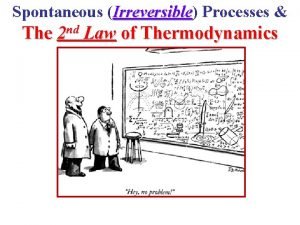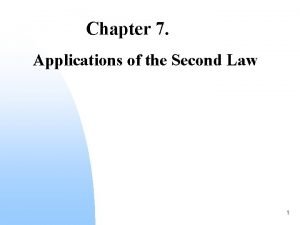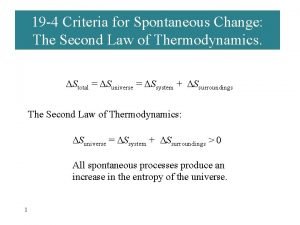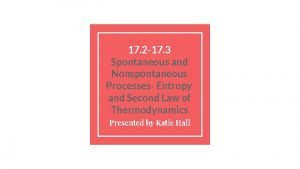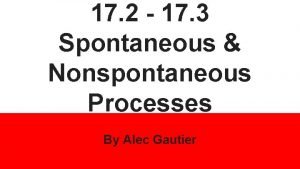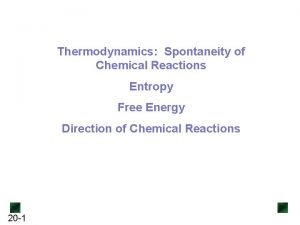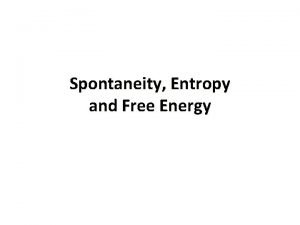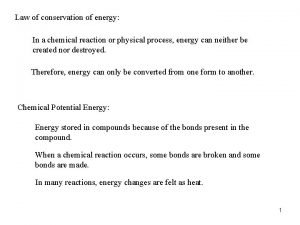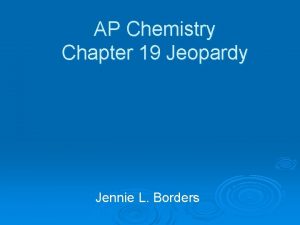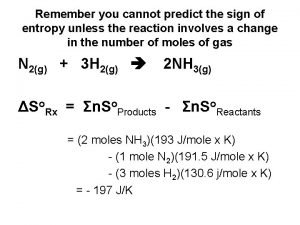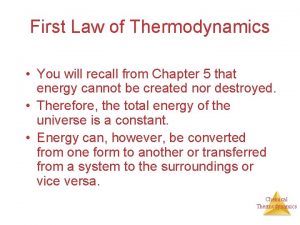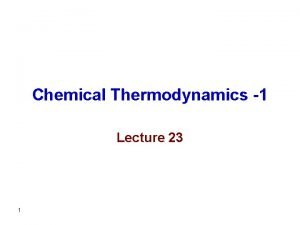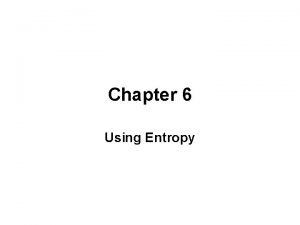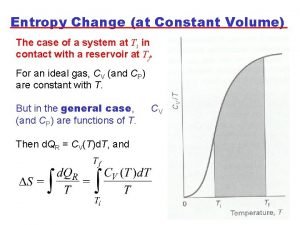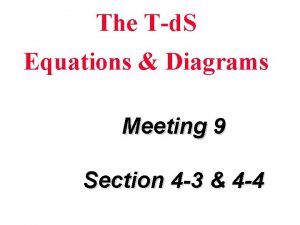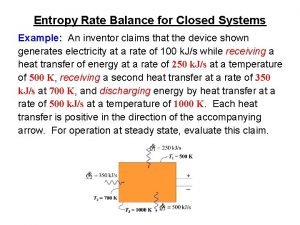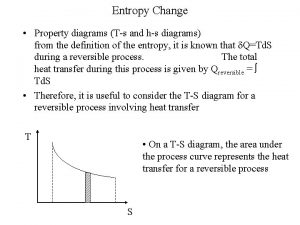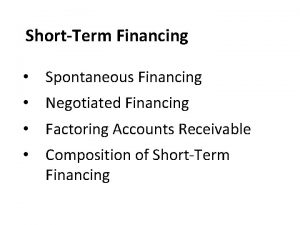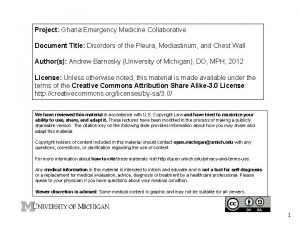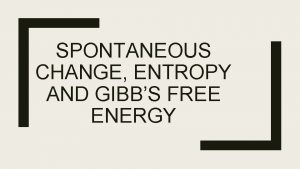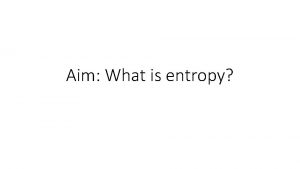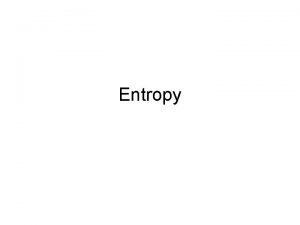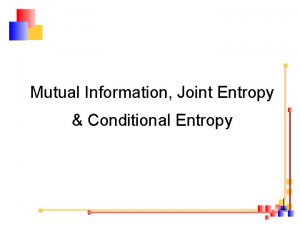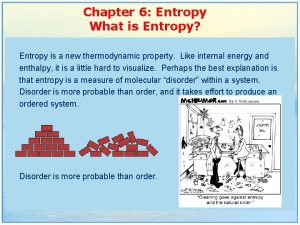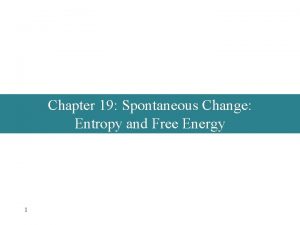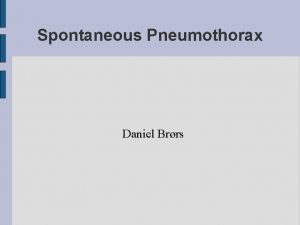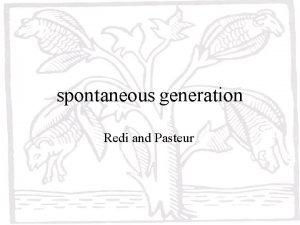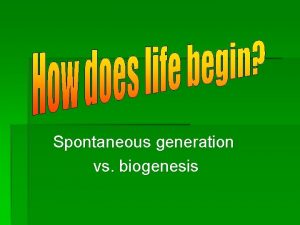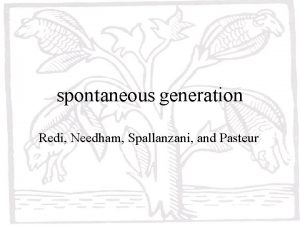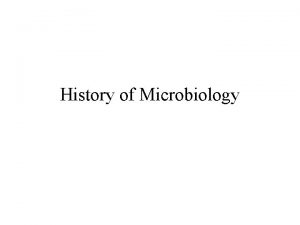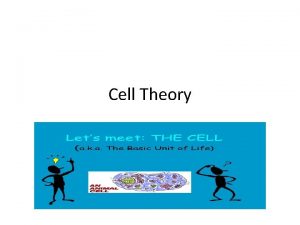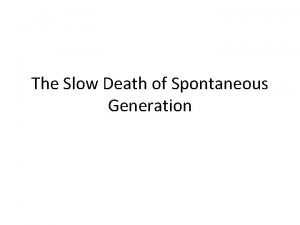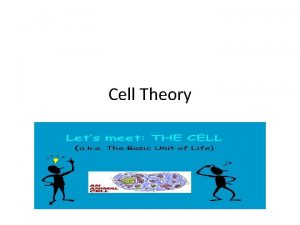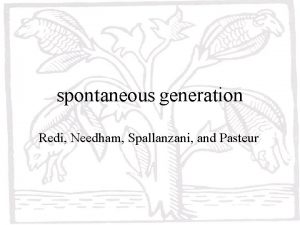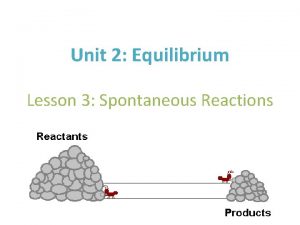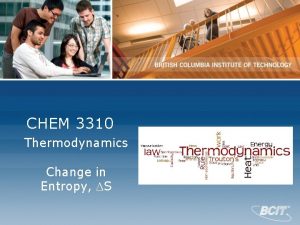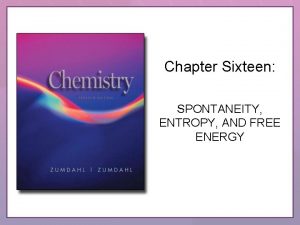ENTROPY Entropy change S A SPONTANEOUS PROCESS e






















- Slides: 22

ENTROPY Entropy change (∆S) A SPONTANEOUS PROCESS (e. g. diffusion) will proceed on its own without any external influence A problem with ∆H Ø A reaction that is exothermic will result in products that are more thermodynamically stable than the reactants. Ø This is a driving force behind many reactions and causes them to be spontaneous (occur without any external influence). Some spontaneous reactions, however, are endothermic. How can this be explained? We need to consider something called entropy

Entropy, S˚ Substances with more ways of arranging their atoms and energy (more disordered) have a higher entropy. System and Surroundings Entropy is a description of the number of ways atoms can share quanta of energy. If number of ways of arranging the energy (W) is high, then system is disordered and entropy (S) is high. When considering entropy it is useful to split the system (the chemicals) from the surroundings. A system will consist of reactants and then products. It does not change temperature or pressure, and mass cannot be transferred to the surroundings. Energy can be transferred to the surroundings

Entropy of the System, S˚system Ø Solids have lower entropies than liquids which are lower than gases. Ø When a solid increases in Temperature its entropy increases as the particles vibrate more. Ø There is a bigger jump in entropy with boiling than that with melting. Ø Gases have large entropies as they are much more disordered At 0 K substances have zero entropy. There is no disorder as particles are stationary

Predicting Change in entropy ‘∆SOsystem ’ Qualitatively An increase in disorder and entropy will lead to a positive entropy change ∆S˚system = +ve Balanced chemical equations can often be used to predict if ∆S˚system is positive or negative. NH 4 Cl (s) HCl (g) + NH 3 (g) In general, a significant increase in the entropy will occur if: -there is a change of state from solid or liquid to gas - there is a significant increase in number of molecules between products and reactants. ∆S˚system = +ve • change from solid reactant to gaseous products • increase in number of molecules both will increase disorder

Na(s) + ½Cl 2(g) Na. Cl(s) ∆S˚system = -ve • change from gaseous and solid reactant to solid • decrease in number of molecules both will decrease disorder

Calculating ∆S˚system quantitatively Data books lists standard entropies (S˚) per mole for a variety of substances. It is not possible for a substance to have a standard entropy of less than zero. Elements in their standard states do not have zero entropy. Only perfect crystals at absolute zero (T = 0 K) will have zero entropy: The unit of entropy is J K-1 mol-1 ∆S˚system = ΣS˚products - ΣS˚reactants

Example Calculate ∆S˚ for the following reaction at 25˚C: 2 Fe 2 O 3 (s) + 3 C (s) 4 Fe (s) + 3 CO 2 (g) Answer S [Fe 2 O 3 ] = 87. 4 J K-1 mol-1 S [C] = 5. 7 J K-1 mol-1 S [Fe] = 27. 3 J K-1 mol-1 S [CO 2 ] = 213. 6 JK-1 mol-1 ∆S˚system = ΣS˚products - ΣS˚reactants = (3 x 213. 6 + 4 x 27. 3) – (2 x 87. 4 + 3 x 5. 7) = + 558. 1 JK-1 mol-1 = + 558 JK-1 mol-1 (3 S. F. ) Note: the entropy change is very positive as a large amount of gas is being created increasing disorder

Entropy of the Surroundings ∆Ssurrounding The surroundings are the container, air, solvent Ø In an exothermic reaction energy is given out into the surroundings. Ø The number of ways of arranging the energy therefore increases and so ∆Ssurrounding increases and is positive. Ø In an endothermic reaction energy is transferred from the surroundings. Ø The number of ways of arranging the energy in the surroundings therefore decreases and so ∆Ssurrounding decreases and is negative.

Total Entropy change ∆Stotal = ∆SOsystem + ∆SOsurrounding For any reaction to be spontaneous then ∆Stotal must be positive. If a reaction is not spontaneous i. e. it doesn’t go, then ∆Stotal will be negative.

Example: Data for the following reaction, which represents the reduction of aluminium oxide by carbon, are shown in the table. Al 2 O 3 (s) + 3 C(s) → 2 Al(s) + 3 CO(g) Calculate the values of ∆Ssystem, ∆H , ∆Ssurroundings and ∆STotal for the above reaction at 298 K 1. Calculate ∆Ssystem ∆S˚ = ΣS˚products - ΣS˚reactants = (2 x 28 + 3 x 198) – (51 + 3 x 6) = +581 J K-1 mol-1(3 S. F. ) 3. Calculate ∆Ssurroundings 2. Calculate ∆H ∆Ssurrounding = - ∆Hreaction/T = -1336000/298 = - 4483 JK-1 mol-1 ∆H˚ = Σ∆H˚f [products] - Σ∆H˚f [reactants] = (3 x -111) – -1669 = +1336 k. J mol-1 4. Calculate ∆STotal Stotal = ∆Ssystem + ∆Ssurrounding = 581 -4483 = -3902 JK-1 mol-1 ∆STotal is negative. The reaction is not feasible

Calculating the temperature a reaction will become feasible Calculate the temperature range that this reaction will be feasible N 2(g) + O 2 (g) 2 NO(g) ∆ H = 180 k. J mol-1 ∆Ssystem = 25 J K-1 mol-1 The reaction will be feasible when ∆STotal ≥ 0 Make ∆STotal = 0 in the following equation ∆ Stotal = ∆Ssystem + ∆Ssurrounding 0 = -∆H/T + ∆Ssystem So T= ∆H / ∆Ssystem T = 180/ (25/1000) = 7200 K The T must be >7200 K which is a high Temp!

∆STotal during phase changes As physical phase changes like melting and boiling are equilibria, the ∆STotal for such changes is zero. What temperature would methane melt at? CH 4(s) CH 4(l) ∆H = 0. 94 k. Jmol-1 ∆S = 10. 3 Jmol-1 K-1 Make ∆STotal = 0 in the following equation ∆ Stotal = ∆Ssystem + ∆Ssurrounding 0 = -∆H/T + ∆Ssystem So T= ∆H / ∆Ssystem T= 0. 94 / (10. 3÷ 1000) T= 91 K

Effect of Temperature on feasibility ∆Stotal = -∆H/T + ∆Ssystem Changing Temperature will change the value of - ∆H/T in the above equation If the reaction involves an increase in entropy of the system (∆Ssystem is +ve) then increasing Temperature will make the -∆H/T have a smaller magnitude and it will more likely that ∆Stotal will be positive and more likely that the reaction occurs e. g. Na. Cl + aq Na+(aq) + Cl-(aq)

If the reaction involves an decrease in entropy (∆Ssystem is -ve) then increasing Temperature will make it more less likely that ∆Stotal will be positive because the -∆H/T will have a smaller magnitude and will be less likely to compensate for the negative ∆Ssystem It will be less likely for the reaction to occur. E. g. HCl(g) + NH 3(g) ➝ NH 4 Cl(s) If the reaction has a ∆H close to zero then temperature will not have a large effect on the feasibility of the reaction as - ∆H/T will be small and ∆ Stotal won’t change much

Solubility of ionic substances Enthalpy of lattice formation The Enthalpy of lattice formation is the standard enthalpy change when 1 mole of an ionic crystal lattice is formed from its constituent ions in gaseous form. Na+ (g) + Cl- (g) Na. Cl (s) [∆H Latt = -787 k. J mol-1] Enthalpy of Hydration ∆Hhyd • Enthalpy change when one mole of gaseous ions become hydrated such that further dilution causes no further heat change • X+(g) + (aq) X+ (aq) For Li+ ∆Hhyd = -519 k. J mol-1 or • X-(g) + aq X-(aq) For F- ∆Hhyd = -506 k. J mol-1 This always gives out energy (exothermic, -ve) because bonds are made between the ions and the water molecules

Enthalpy of solution The enthalpy of solution is the standard enthalpy change when one mole of an ionic solid dissolves in an large enough amount of water to ensure that the dissolved ions are well separated and do not interact with one another Na. Cl(s) + aq Na+(aq) + Cl-(aq)

Trends in Lattice Enthalpies The strength of a enthalpy of lattice formation depends on the following factors: 1. The sizes of the ions: The larger the ions, the less negative the enthalpies of lattice formation (i. e. a weaker lattice). As the ions are larger the charges become further apart and so have a weaker attractive force between them. 2. The charges on the ion: The bigger the charge of the ion, the greater the attraction between the ions so the stronger the lattice enthalpy (more negative values). e. g group 1 halides (eg Na. F KI) have lattice enthalpies of around – 700 to - 1000 group 2 halides (eg Mg. Cl 2 ) have lattice enthalpies of around – 2000 to – 3500 group 2 oxides (eg Mg. O) have lattice enthalpies of around – 3000 to – 4500 k. Jmol-1 The lattice enthalpies become less negative down any group. e. g. Li. Cl, Na. Cl, KCl, Rb. Cl

Enthalpies of solution Using Hess’s law to determine enthalpy changes of solution When an ionic lattice dissolves in water it involves breaking up the bonds in the lattice and forming new bonds between the metal ions and water molecules. For Mg. Cl 2 the ionic equation for the dissolving is Mg. Cl 2 (s) + aq Mg 2+ (aq) + 2 Cl- (aq) Ø When an ionic substance dissolves the lattice must be broken up. Ø The enthalpy of lattice dissociation is equal to the energy needed to break up the lattice (to gaseous ions). Ø This step is endothermic. Ø The size of the lattice enthalpy depends on the size and charge on the ∆H solution = - ∆ HL formation + Σ∆Hhyd ion. Ø The smaller the ion and the higher its charge the stronger the lattice

Example Calculate the enthalpy of solution of Na. Cl given that the: lattice enthalpy of formation of Na. Cl is -771 k. Jmol -1 and the enthalpies of hydration of sodium and chloride ions are -406 and -364 k. Jmol -1 respectively Answer ∆H sol = - ∆ HLatt formation + Σ∆Hhyd = - (-771) + (-406 -364) = + 1 k. Jmol-1 ΔH solution endothermic.

Hydration enthalpies are exothermic as energy is given out as water molecules bond to the metal ions. The negative ions are attracted to the δ+ hydrogens on the polar water molecules and the positive ions are attracted to the δ - oxygen on the polar water molecules. The higher the charge density the greater the hydration enthalpy (e. g. smaller ions or ions with larger charges) as the ions attract the water molecules more strongly. e. g. Fluoride ions have more negative hydration enthalpies than chloride ions Magnesium ions have a more negative hydration enthalpy than barium ions

What does ΔHSolution tell us? Ø Generally ΔH solution is not very exo or endothermic so the hydration enthalpy is about the same as lattice enthalpy. Ø In general the substance is more likely to be soluble if the ΔH solution is exothermic. Ø If a substance is insoluble it is often because the lattice enthalpy is much larger than the hydration enthalpy and it is not energetically favourable to break up the lattice, making ΔH solution endothermic. Ø We must consider entropy, however, to give us the full picture about solubility. Ø When a solid dissolves into ions the entropy increases as there is more disorder as solid changes to solution and number of particles increases. Ø This positive ∆Ssystem can make ∆STotal positive even if ∆H solution is endothermic, especially at higher temperatures.

For salts where ΔH solution is exothermic the salt will always dissolve at all Temperatures For salts where ΔH solution is endothermic the salt may dissolve depending on whether the ∆S value is more positive than -∆H/T is negative Increasing the Temperature will make it more likely that ∆STotal will become positive, making the reaction feasible and the salt dissolve
 In a spontaneous irreversible process
In a spontaneous irreversible process Entropy in adiabatic expansion
Entropy in adiabatic expansion Criteria for spontaneous process
Criteria for spontaneous process Non spontaneous process
Non spontaneous process Entropy
Entropy Non spontaneous process definition
Non spontaneous process definition Spontaneous reaction
Spontaneous reaction Concept of free energy
Concept of free energy Examples of spontaneous process
Examples of spontaneous process Classify each process as spontaneous or nonspontaneous.
Classify each process as spontaneous or nonspontaneous. Kelvin statement
Kelvin statement δhsys
δhsys Entropy change formula
Entropy change formula Entropy of system and surroundings
Entropy of system and surroundings Entropy change of surroundings formula
Entropy change of surroundings formula Units of entropu
Units of entropu Entropy change at constant volume formula
Entropy change at constant volume formula Efeito joule
Efeito joule Entropy rate balance
Entropy rate balance Ts diagrams
Ts diagrams Spontaneous sources of financing
Spontaneous sources of financing Light's criteria
Light's criteria Spontaneous transmutation equation
Spontaneous transmutation equation
